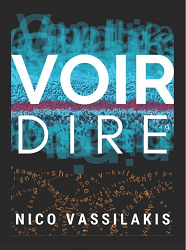
Voir Dire (Dusie, 2020)
First things first. But what comes first when faced with a book? The fact of the author? The title? The image on the cover? That all depends on how you find it. Let’s say, considering that you aren’t going to be browsing the sad poetry section of Chapters and stumble on this book—it won’t be there—let’s assume that most readers will approach this book because Nico Vassilakis. And yes, this book is Nico Vassilakis—very much so—though, perhaps not exactly how you might expect Nico Vassilakis. Let’s come back to that.
Voir Dire. Here is the title. Forgive my ignorance, but what is that? Ah! It’s a legal term—no wonder it was so strange to me. Of course, you knew it right away. Most of you, of course. But, if you’re anything like me, you don’t. The online Merriam-Webster dictionary defines voir dire as a preliminary examination to determine the competency of a witness or juror. What are we getting ourselves into? What crime has been committed? Who is the witness or juror, and who is judging their competency? But it is important to note that the etymology of voir dire is Anglo-French, literally, to speak the truth.
Before the book is opened there still remains the image on the cover. We’ve all moved passed the cliché never judge a book by its cover, I hope. It’s like saying disregard first impressions. Who would do that?
The image we find on the cover is the Nico we know. A visceral frothing of blue letters through which there is a streak of red—and below that froth (of sea, of mouth) circles composed of brown sentences.
So, before opening the book we already have quite a lot of information that gives us some idea of what lies ahead. Not lies. Truth. At least an angle of honesty. Though it is certainly true that Vassilakis has published an extensive amount of poetry and prose that is not visual in its focus, what he is known for is his vispo. So, it might come as some surprise that this book contains no visual poetry, save one very minimal piece at the conclusion of the work. No, this book is called Voir Dire, and what we get is Vassilakis thinking about looking, thinking about visual poetry—thinking about a life in looking, exploring—thinking about being seen.
There has been no crime. We witness Vassilakis witnessing. Yes, this is confession, but more than that Voir Dire is a desperate attempt to sort. This is not a worked-out thesis, it is a process, and as such it is messy, dizzying—downright fractured. The book swings from observation to manifesto, inner struggle to address—and as readers we are inserted into this mindscape of uncertainty. It is, in fact, the process. Here is an unfiltered glimpse into the void that cheers on each artist.
“Being a poet, a real poet, is becoming near impossible in this world. Too many other concerns have made us into hybrid poets, living as poets in tangential situations. How are we able to maintain focus in this accelerated environment?”
Indeed, how focus? How focus on the image—how focus on this work? There is no answer. The jury is hung. But we must try. Perhaps there has been a crime, but if there has it blends perfectly into ‘things as they are’. I hate ‘things as they are’.
